Oh! Are there Termite Tubes Hanging from Ceiling?
I noticed a small hole where a hanging tube used to be. Later, I saw a similar tube in the same spot, about 5 inches long and a quarter-inch wide. It looked just like the first one. Strangely, I haven’t spotted any bugs nearby. I checked outside my house and noticed some lines at the base that seemed drawn using mud. Are there “Termite tubes hanging from ceiling”?
Termites can be a problem. They can harm various parts of your home, including ceilings. The damage they cause to ceilings is serious, leading to sagging and bending, which can be expensive to repair. But here’s a question: do termites actually hang from the ceiling?
What Are Termite Tubes?
What do termite tubes look like? Termite tubes, also known as “mud tubes” or “termite tunnels,” are distinctive structures built by termites for protection and movement. Soil, wood shavings, and termite saliva are used to construct these tubes. Termites use them from their nests to the wood they eat, typically found in homes.
The Role of Termite Tubes in the World of Termites
Protection and Safety:
Termites are vulnerable to external factors like light, air, and predators. Termite tubes provide a protective shield, allowing termites to move freely between their colony and feeding grounds without exposing themselves to potential threats.
Climate Control:
Termites thrive in a moist environment. Termite tubes help regulate humidity levels by retaining moisture, ensuring that the termites’ delicate bodies remain hydrated and facilitating optimal conditions for their survival.
Stealthy Movement:
Termite tubes enable termites to travel discreetly. These tunnels keep termites hidden from predators and humans as they carry out their vital tasks of foraging for food and expanding their colonies.
Guided Navigation:
Termite tubes serve as navigational highways for termites. These tiny creatures are known for their remarkable organization, and these tubes guide them to their desired destinations, ensuring efficient movement throughout their intricate underground world.
Resource Exploration:
The tubes extend into new territories, providing termites access to untapped resources. They can establish new feeding sites as they encounter potential food sources, helping their colonies thrive and grow.
Colony Expansion:
Termites use tubes to help their colonies grow. These tunnels enable termites to explore new areas and locate suitable sites for establishing satellite colonies, contributing to the population’s growth and distribution.
Symbiotic Relationships:
For example, certain termites form symbiotic partnerships with fungi. Termite tubes can create environments conducive to these relationships, benefiting both termites and their symbiotic partners.
Ecological Impact:
Termite activity has ecological implications, including soil aeration and nutrient recycling. Termite tubes facilitate the movement of termites within soil and substrates, contributing to these important ecological processes.
What Do Termites In Ceiling Look Like?
When termites enter your home and ceiling, they often create hanging tubes out of mud that extend through the walls. If you’ve encountered unusual sandy structures hanging from your walls or ceiling, it’s a sign that you need to address the issue of termite tubes hanging from the ceiling.
Subterranean Termites typically live underground but can chew their way into houses. They navigate through homes using “Mud Tubes,” which they construct using their waste. These termites continuously feed on wood, working 24/7 and never taking a break, which can lead to substantial damage.
Observing these hanging formations on your ceiling indicates that termites have traveled from the ground through your walls and are likely damaging your roof trusses.
Managing termites is crucial for homeowners. Even though they might not be visible, they can create significant problems. There are methods to eliminate termite tubes hanging from the ceiling. In this article, we’ll explore different approaches, discuss safety measures, and underscore the urgency of taking quick action to prevent further harm. By following the right steps, you can successfully eradicate termites from your ceiling and uphold the strength and safety of your home.
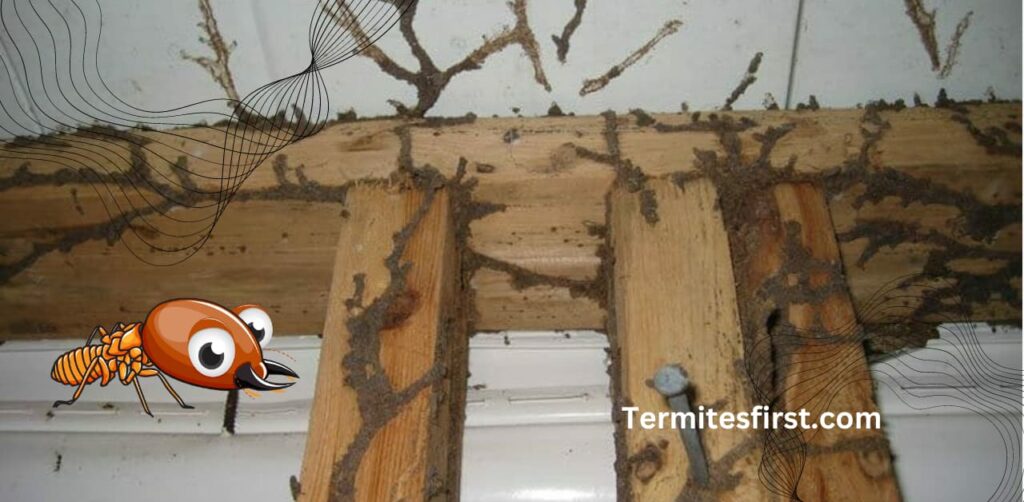
Top 10 Early Stage Signs of Termites in Ceiling
Detecting termites in the early stages, especially in ceilings, is crucial for preventing extensive damage to your home.
Mud Tubes:
Check the walls, ceilings, and foundation for thin tubes made of what seems like mud. Termites make these tunnels from the colony to the food source. Finding them could indicate termite activity.
Tiny Holes:
Look for small holes or openings in the ceiling or walls. These can be entry points that termites use to access the wood. Check for any unexplained deterioration in the wood.
Sagging or Buckling:
If you notice ceiling areas that are sagging or buckling, it could be due to termite damage. Termites weaken the wood structure, causing it to lose its integrity.
Peeling Paint or Discoloration:
Paint that appears bubbled, cracked, or peeling for no apparent reason might result from termite activity beneath the surface. Discoloration can also be a sign of termite presence.
Discarded Wings:
Swarmers, or winged termites, shed their wings after mating. Finding discarded wings around windowsills, vents, or on the floor could indicate a nearby termite colony.
Audible Sounds:
It could be termites at work if you hear faint tapping or rustling sounds from within the walls or ceiling. They make a lot of noise when they gnaw on wood for food.
Frass:
Droppings from termites, known as “frass,” look like little pellets of wood. Finding frass around small holes or openings could indicate termites burrowing into the wood.
Hollow-Sounding Wood:
Gently tapping on wooden surfaces and noticing a hollow sound could indicate termite damage. Termites consume wood from the inside, creating a hollowed-out structure.
Increased Moisture:
Termites thrive in moist environments. It could attract termites if you notice an increase in moisture or dampness in or around the ceiling.
Visible Termites:
Sometimes, especially during a termite swarm, you may see termites near the ceiling or flying around light sources.
Understanding Termite Tubes: Infestations, Risks, and Prevention in Ceilings
Can Termites Live In Ceiling? Yes, termites can indeed live in ceilings, and their presence in this area can lead to significant problems for homeowners. Termites are highly adaptable pests that can infest various home parts, including ceilings. Here’s what you need to know about termites living in ceilings:
Concealed Infestations:
The capacity to conceal their presence is a hallmark of termites. They can infest ceilings without being easily detected by constructing mud tubes to move through walls and structures. These tubes help them maintain the necessary humidity levels and protect them from exposure.
Structural Damage:
If termites establish a presence in ceilings, they can cause extensive damage over time. They eat cellulose-based materials like wood, which compromises the roof’s stability. Failure to repair this damage might lead to drooping, warping, or even collapse.
Entry Points:
Termites can access ceilings through various entry points, such as gaps, cracks, and joints. They may also use plumbing or electrical penetrations as pathways to infest ceilings.
Signs of Infestation:
While termites in ceilings may remain hidden, certain signs can indicate their presence. These include the appearance of mud tubes, tiny holes in wood surfaces, discarded wings near windows or light fixtures, and the sound of tapping or rustling coming from within walls.
Prevention and Treatment:
Regular inspections, fixing moisture problems, sealing entry holes, and keeping wood products off the ground are important for preventing termite infestations in ceilings. If termites are found in the ceiling, professional termite treatment procedures must be used to eradicate the infestation and avoid any additional damage.
Do Termites Hang from the Ceiling? Exploring Termite Behavior and Infestations
The question often arises: do termites hang from the ceiling? Let’s delve into this intriguing aspect of termite behavior, shedding light on their habits and the potential risks they pose to your home.
Termites, those persistent and secretive insects, have a knack for infiltrating the most inconspicuous corners of our living spaces. While they may not exactly “hang” like bats, they can infest ceilings. These pests are masters of concealment, often moving undetected through walls and structures by constructing what is known as termite tubes, also referred to as mud tubes.
These termite tubes serve multiple purposes. First and foremost, they act as protective pathways, enabling termites to traverse between their underground colonies and the cellulose-rich feeding grounds located within the heart of your home. Shielded from the dangers of light and air, termites can carry out their activities stealthily, making ceilings just as susceptible to infestation as any other part of your property.
Moreover, termite tubes can signal the beginning of a potentially serious problem. Termites are voracious eaters, particularly of wood and other cellulose materials. If left unchecked, their relentless feasting can compromise the structural integrity of ceilings, leading to sagging, weakening, and even structural failure.
How long Does it Take Termites to Build Mud Tubes Ceiling?
How long it takes for termites to construct a mud tube network in your ceiling depends on a number of factors, including the kind of termite, the surrounding climate, and the size of the colony. However, termites are generally efficient builders, and they can construct mud tubes relatively quickly when conditions are favorable.
In some cases, termites can establish mud tubes within days or weeks. This rapid construction is facilitated by their natural instinct to create protective pathways for efficient movement between their colony and a food source.
It’s important to note that termite behavior can be influenced by factors such as temperature, humidity, availability of food, and the termite colony’s size and maturity. Additionally, the extent of the infestation and the specific location on the ceiling can impact the time it takes for mud tubes to become noticeable.
If you suspect termite activity or see the formation of mud tubes on your ceiling, it’s crucial to take immediate action. The severity of the infestation and the accompanying expenditures can be minimized if you take prompt action. If you want to precisely diagnose, analyze, and treat termite concerns, it’s best to consult with a professional pest control specialist.
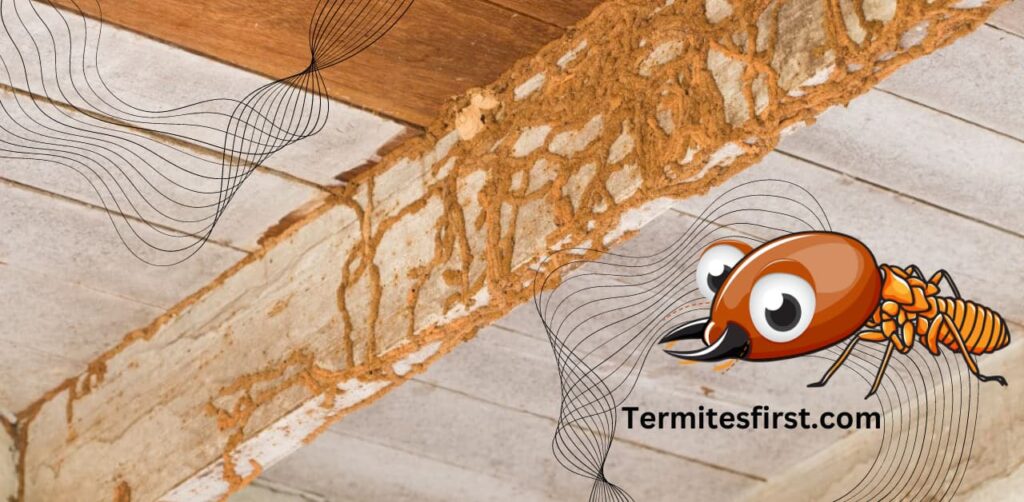
Do Termites Make Holes in the Ceiling?
Yes, termites are capable of making holes in ceilings. When termites infest a structure, they often create tunnels and galleries within the wood, forming small holes in surfaces such as ceilings, walls, and floors. These holes result from termites tunneling through the wood as they search for cellulose-rich materials to feed on.
Termites are relentless in their search for food, and they can cause damage to wooden structures by excavating tunnels and galleries. Developing the channels, they produce compromises its strength. Holes might appear on the surface due to the buildup of damage.
It’s crucial to find out why there are little holes in your home’s ceiling or other wooden surfaces. Although termites are a common suspect, other causes might be at play. Seek the help of a professional pest treatment company if you find evidence of termites. They can assess the situation, identify the pest responsible, and recommend appropriate measures to address the issue and prevent further damage.
Do Termites Come Out Of The Ceiling?
Termites typically don’t come out of the ceiling like insects might emerge from a hidden space. Termites are subterranean insects that live in underground colonies and construct mud tubes to move between their colony and sources of food, which often include wood in buildings.
However, if there is a significant termite infestation within the walls or ceiling of a structure, termites might become more visible. You might observe signs such as:
Mud Tubes:
Termites may construct mud tubes extending from the ground to the walls and ceilings. These tubes provide a protected pathway for termites to move around while avoiding exposure to light and air.
Frass:
Termite droppings, known as “frass,” might be found near or below openings or cracks in the ceiling. These can indicate termite activity within the ceiling.
Swarmers:
In some cases, termite swarmers (winged reproductive termites) might emerge from small openings or cracks in the ceiling. This usually indicates an advanced infestation and is a sign that a termite colony is well-established.
Termite activity within ceilings is often hidden and can be challenging to detect. Regular inspections by a professional pest control expert are recommended to identify and address any termite issues before they cause significant damage.
Termites Falling From Ceiling Vent
If you are observing termites falling from a ceiling vent, it could indicate a more advanced termite infestation within the structure. Here’s what you should be aware of and steps you can take:
Advanced Infestation:
Termites falling from a ceiling vent suggests that the infestation has progressed to a point where termites are actively moving within the building’s structure. This is a cause for concern, as it indicates that termites are present and potentially causing significant damage.
Swarmers:
When termites reach a certain stage in their lifecycle, they produce winged reproductive individuals known as swarmers or alates. These swarmers start new colonies. If you see termites falling from a ceiling vent, swarmers are attempting to establish new colonies.
Immediate Action:
Seeing swarmers or termites falling from a ceiling vent requires prompt action. Contact a pest treatment company to inspect and establish the type of termite present and the degree of the infestation. They can provide appropriate recommendations for treatment and control.
Professional Inspection:
A professional inspection will help identify the infestation’s severity and the affected areas. Specialists in termite management can devise an effective strategy to eliminate pests and stop additional harm.
Preventive Measures:
Even after treatment, addressing conditions that may attract termites to your property is essential. This includes reducing moisture sources, removing wood-to-soil contact, and sealing entry points.
Regular Inspections:
To prevent future infestations, schedule regular termite inspections by professionals. Early detection and treatment are critical to minimizing damage and potential costs.
Preventing Termite Ceiling Damage:
Termites can wreak havoc on your home, especially on the ceiling. Preventative maintenance is a must to keep your house in good shape and save money on repairs.
To prevent termite damage to your ceiling, follow these effective strategies:
Reduce Moisture:
Wet places are perfect for termites. Reduce humidity with fast leak repairs and adequate ventilation.
Remove Wood-to-Soil Contact:
Termites will tunnel through dirt to get inside your house. The ground should not come into touch with any wooden parts.
Regular Inspections:
Professional termite inspections should be scheduled regularly to ensure early infestation detection.
Termite-Resistant Materials:
When making house improvements, consider utilizing materials resistant to termites.
Professional Treatment:
If you spot any termite activity, seek professional assistance for thorough treatment and prevention.
Should I Knock Down Termite Tubes?
Do not, under any circumstances, try to destroy termite tubes on your own. Termite tubes, also known as mud tubes, serve as a vital indicator of termite activity. Knocking them down without proper knowledge and professional assistance can be counterproductive and potentially worsen the situation. Here’s why:
Knocking down termite tubes might seem like a quick solution, but it’s not the best approach. Termites build these tunnels to keep them safe and hydrated as they travel from their colonies to their food sources. Simply removing the tubes won’t eliminate the termites. Instead, you should talk to an expert in pest treatment. They can assess the situation, identify the termite species, and provide appropriate treatment to eliminate the infestation.
What Are Termite Tubes Made Of?
Termite tubes, also known as mud tubes, are fascinating structures that termites construct for their survival. Let’s delve into the composition of these tubes and their significance.
Informational Data:
Termite tubes contain soil, wood particles, termite saliva, and fecal matter. These tubes serve multiple purposes for termites.
Protection:
As they make their way from the colony to the food source, termites are protected from the elements and any threats by the tubes they construct.
Moisture Regulation:
Termites require a humid environment to thrive. The tubes help maintain optimal moisture levels.
Navigation:
The tubes act as pathways, efficiently guiding termites to their destinations.
How to Treat Termites in Ceiling?
How to Get Rid of Termites in Ceiling? Eliminating an infestation of termites in the ceiling and preventing future damage calls for an organized and efficient treatment strategy. Termites in the ceiling? Here’s a step-by-step method to getting rid of them:
Professional Inspection:
Get in touch with an established pest control company first. Your whole home, including the ceiling, will be inspected for signs of termites. This inspection will help determine the appropriate treatment strategy.
Treatment Plan Development:
The inspection results will create a unique strategy for treating the pest problem. The plan will consider the termite species, the infestation’s severity, and your home’s construction.
Localized or Whole-Structure Treatment:
Depending on the extent of the infestation, the pest control expert will decide whether a localized treatment targeting the ceiling area is sufficient or a more comprehensive whole-structure treatment is necessary.
Chemical Treatments:
Termites can be killed with chemical treatments. The pest control expert may apply liquid termiticides to the affected areas, including the ceiling, where termites are active. These termiticides are designed to eliminate termites effectively upon contact.
Baiting Systems:
In some cases, baiting systems might be recommended. These involve placing termite baits near termite activity areas. Termites consume the bait, carry it back to the colony, and kill out every last colony member.
Follow-Up Inspections:
To confirm the treatment was successful and to avoid reinfestation, it is essential to do regular follow-up inspections after the first treatment. Experts in pest control will monitor things and make any necessary modifications.
Addressing Entry Points:
Finding and sealing the locations where the termites entered the ceiling is crucial for preventing further infestations. Sealing these entry points will help prevent new termite infestations.
Implement Preventive Measures:
Professionals in pest control can offer advice for continued termite protection. Controlling humidity, avoiding contact between wood and soil, and routine checks for termites are all helpful.

How to Remove Termite Mud Tubes from Ceiling?
When removing termite mud tubes, a cautious approach is essential to address the infestation and prevent further damage effectively. If you want to get rid of pests for good, you should first talk to someone trained and certified. These experts possess the specialized knowledge and tools for safe and thorough removal. They will eliminate the tubes and identify the entry points that termites use to access your property, sealing them off to prevent future infestations.
A crucial aspect often overlooked is addressing the underlying termite infestation. Professionals will develop a tailored treatment plan, employing chemical treatments or baiting systems to target the termite colony and prevent their return. The success of the therapy and the absence of reinfestation depends on thorough, routine checks afterward.
Experts in pest control address the present problem and advise on how to avoid future infestations. These measures, including reducing moisture, proper ventilation, and avoiding wood-to-soil contact, are vital in keeping termites at bay. It’s important to recognize that removing termite mud tubes is just a part of the larger process, and the comprehensive approach professionals provide is necessary for a termite-free environment.
While the idea of removing mud tubes yourself might seem tempting, the complexities of termite behavior and treatment necessitate professional expertise. Attempting DIY removal could lead to unintended consequences, worsening the infestation or not fully addressing it. To resolve the issue, seek the assistance of experienced pest control professionals who can effectively remove mud tubes, treat the infestation, and provide guidance on long-term prevention, ensuring your property remains termite-free.
How to Safely Eliminate Termites in Soil: Natural Methods and Prevention
How do you kill termites in soil naturally? Termites can cause significant damage to your home as well as a significant financial burden. If you’re dealing with a termite infestation in your soil, it’s crucial to address the issue promptly and effectively. In this guide, we’ll explore natural methods to eliminate termites in the soil while keeping your environment safe and eco-friendly.
Natural Methods to Eliminate Termites in Soil:
Beneficial Nematodes:
Harness the power of nature by employing beneficial nematodes. These small worms are useful because they feed on termites, reducing their numbers. Apply a nematode-and-water mixture to the afflicted soil. While nematodes won’t completely eradicate termites, they can significantly reduce their numbers.
Solar Exposure:
Termites are sensitive to heat and sunlight. Utilize this weakness to your advantage by exposing the infested soil to sunlight. Solarizing the soil involves covering it with plastic sheets, allowing the sun’s heat to penetrate and kill termites naturally.
Cardboard Traps:
Termites are drawn to cellulose, abundant in cardboard. Place a piece of moist cardboard near the affected region to lure termites. Once they’ve gathered on the cardboard, you can remove and destroy it, eliminating a portion of the termite colony.
Diatomaceous Earth:
This abrasive powder is made from fossilized diatoms, a naturally occurring mineral known for its ability to dehydrate insects on contact.. Sprinkle diatomaceous earth around the infested soil to deter and kill termites. Opt for food-grade diatomaceous earth for safety.
Orange Oil:
Orange oil contains d-limonene, a compound toxic to termites. Applying or injecting orange oil into termite galleries in the soil can help eliminate them.
Beneficial Plants:
Some plants, such as neem trees and vetiver grass, naturally repel termites. Planting these around the infested area can act as a deterrent, reducing the likelihood of termites entering your property.
Boric Acid:
The use of boric acid to destroy termites is common. Termites are killed when they consume the mixture while foraging after it has been diluted with water and put to the ground. Boric acid can be dangerous to children and pets if not handled carefully.
Preventive Measures for Long-Term Success:
To maintain a termite-free environment naturally, implement these preventive steps:
Moisture Control:
Termites thrive in damp conditions. Fix leaks promptly, ensure proper drainage, and reduce excess moisture around your property.
Regular Inspections:
Inspect your home frequently for mud tubes, termite droppings, and wood damage.
Wood Debris Removal:
Clear away decaying wood, old tree stumps, and other debris that might attract termites.
Proper Landscaping:
Maintain a buffer zone between soil and wooden structures. Avoid direct soil-wood contact to minimize termite access points.
Conclusion:-
In conclusion, the presence of termite tubes hanging from the ceiling is a clear sign of potential termite infestation within your property. These tubes, constructed by termites from a mixture of soil, wood particles, and saliva, serve as vital pathways that provide protection, moisture, and navigation for termites. Attempting to remove termite tubes yourself is not advisable, as it doesn’t address the underlying infestation and can worsen the situation. To effectively deal with termite tubes and the infestation they indicate, it’s essential to consult a licensed pest control professional. These professionals have everything they need to identify the extent of the infestation, devise a proper treatment strategy, and wipe out the termites for good. The structural integrity of your home and the continued absence of termites for years depend on your ability to respond quickly and intelligently. Remember, addressing termite issues requires professional expertise for a successful and lasting solution.
FAQs:-
Termites seldom make tubes that dangle from the roof. They construct these mud tunnels for safety and moisture conservation when traveling from their underground homes to their food sources. These tubes are usually vertical and run along surfaces, such as walls and foundations, rather than hanging down from ceilings. If you’re observing any unusual structures hanging from your ceiling, it’s recommended to inspect them closely and consult a pest control professional if you suspect a termite issue.
If you find them, it’s a good idea to destroy termite tubes. Termites build these tubes for protection while they travel. Removing them disrupts their access and hinders infestation. However, consult a pest control expert to assess the situation and implement effective treatment for a comprehensive solution.
Yes, the presence of termite tubes indicates a termite infestation. These tubes provide protection and moisture for their movement. Finding them suggests active termites. Act quickly by consulting a pest control expert to assess and address the issue to minimize damage.
To eliminate termites from your ceiling, consult a professional pest control service. They’ll assess the infestation, use treatments like termiticides or bait stations, and ensure proper monitoring. Implement preventive measures to avoid future issues. Expert help is key for effective and lasting termite removal.
Wear protective gear to remove termite mud tubes and gently scrape them off surfaces using a scraper or putty knife. After removal, inspect the area for termites, dispose of the tubes in a sealed bag, and consider repairs if needed.

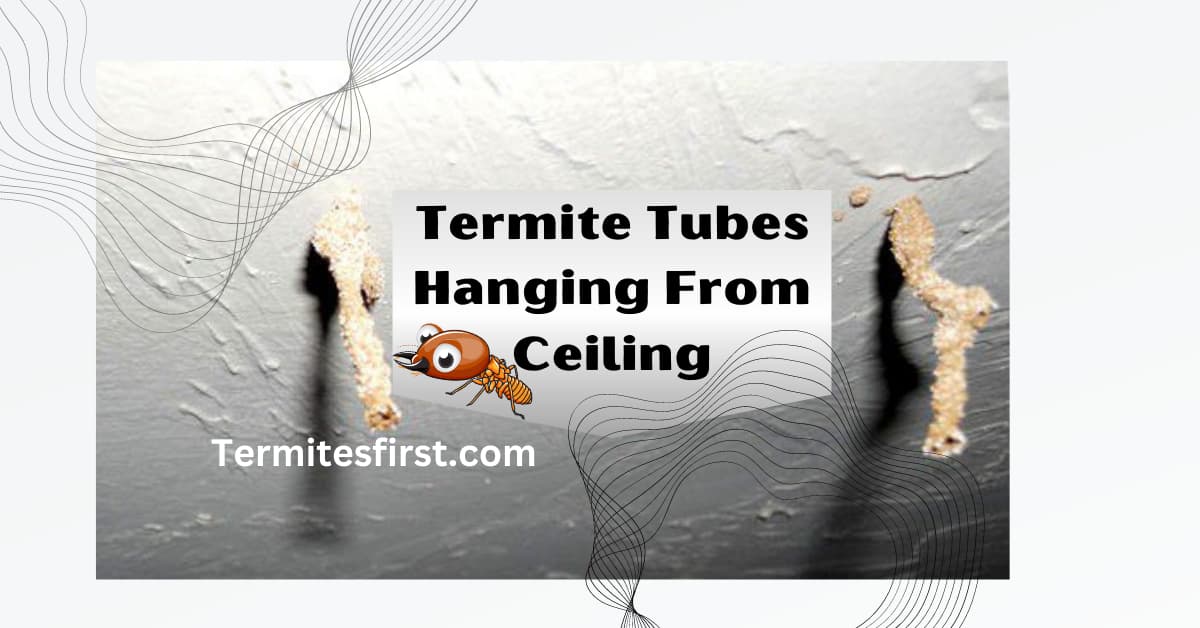
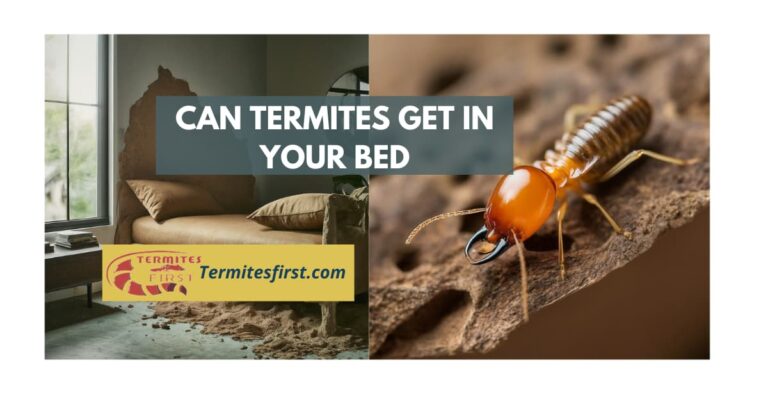
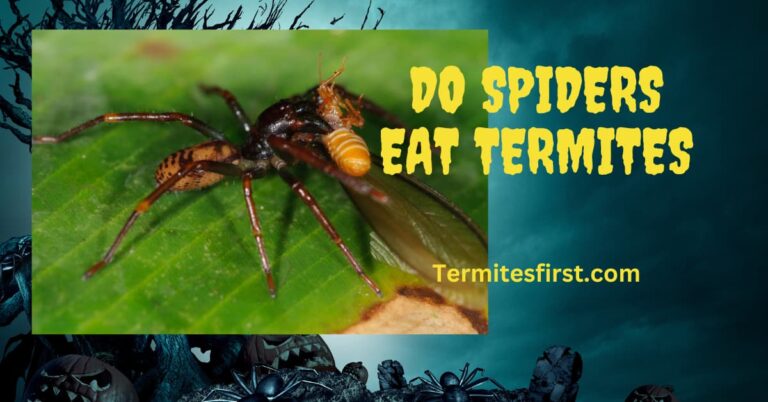
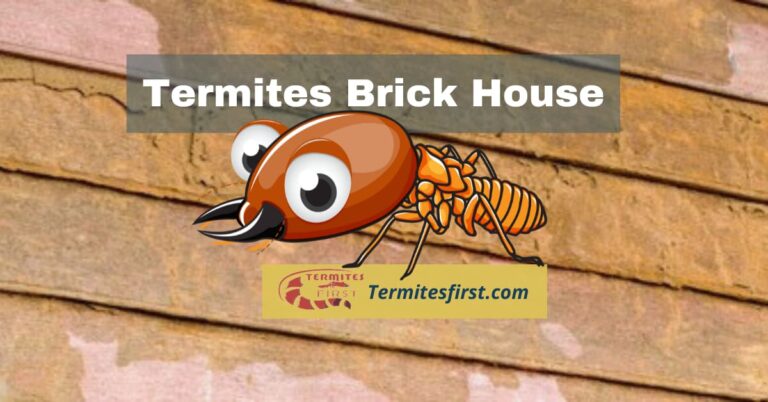


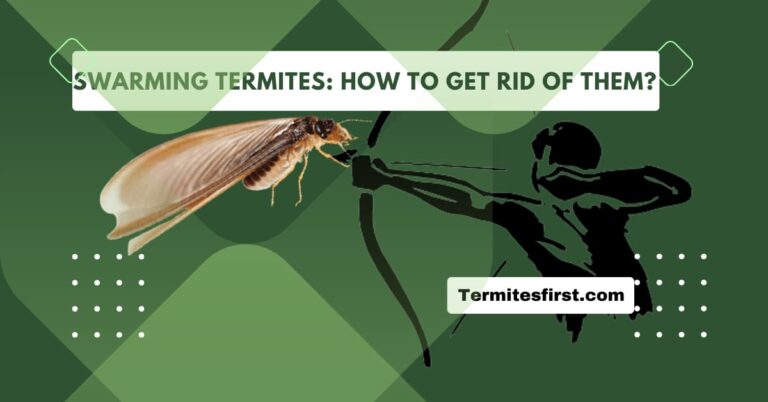
4 Comments